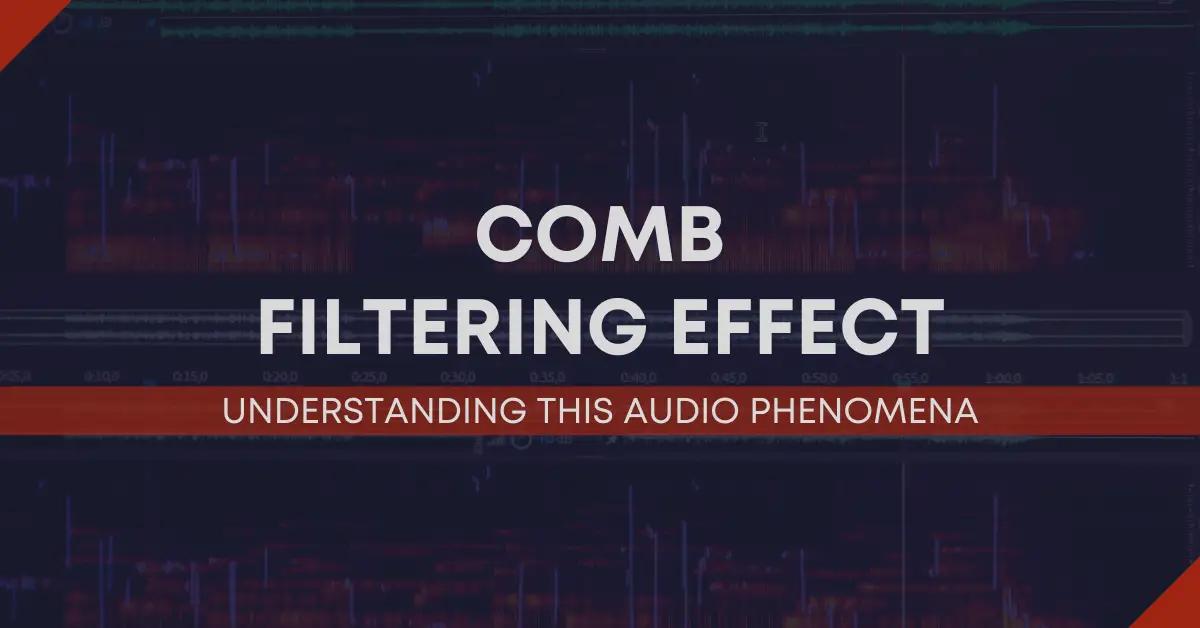
Audio fidelity is paramount, whether you're in the studio meticulously crafting a mix or out in the field doing live sound. A particular stumbling block you may come across is an audio phenomena known as comb filtering. The comb filtering effect occurs when a sound wave with the same frequency arrives at your ears or a microphone at slightly different times. This is often due to time delay or phase cancellation, causing the audio quality to degrade. With roots in both recording and live sound, understanding the nuances of frequency response changes due to comb filtering is important. Read on to learn more!

Audio fidelity is paramount, whether you're in the studio meticulously crafting a mix or out in the field doing live sound. A particular stumbling block you may come across is an audio phenomena known as comb filtering. The comb filtering effect occurs when a sound wave with the same frequency arrives at your ears or a microphone at slightly different times. This is often due to delay or phase cancellation, causing the audio quality to degrade. With roots in both recording and live sound, understanding the nuances of frequency response changes due to comb filtering is important. Read on to learn more!
The sonic fingerprint of comb filtering includes a series of tonal notches or dips across the frequency spectrum. You'll hear these most clearly in environments where there are reflective surfaces or in poorly time-aligned sound systems. The hallmark characteristics are:
Now, let's look at a comparison of how different instruments may be affected by comb filtering in a live sound environment:
| Instrument | Effect Without Comb Filtering | Effect With Comb Filtering |
|---|---|---|
| Drum | Clear, distinct hits with full frequency response | "Flattened" hits with missing overtone frequencies |
| Guitar | Bright, resonant chords with rich harmonics | Thinner, muted sound with reduced presence |
| Vocals | Crisp, consistent tone with smooth reverberation | Variable tone quality with waves of volume shifts and phaseyness |

Comb filtering can significantly degrade the audio quality in both studio recordings and live settings. To mitigate these effects, you can incorporate a variety of proactive measures within your digital workstation and live sound setups. Managing latency, carefully selecting and placing multiple microphones, and designing spaces to avoid reflections are key tactics used by audio professionals to preserve the purity of sound recordings and live performances.
To tackle the challenges of comb filtering, start by optimizing your digital workstation. In today's sophisticated audio environments, latency can be an enemy to sound clarity. Use high-quality plugins designed to minimize latency and ensure your DAW is configured for optimal performance. This helps in keeping your audio signals time aligned and reduces the chance of comb filtering.
When recording with multiple microphones, be mindful of their placement relative to the sound sources and each other to avoid phase cancellation. Aim to capture the direct sound without the interference of reflections off hard surfaces.
In live settings, where the control of reflections is more complex, monitor speaker placement closely. Ensure the speakers are positioned to provide optimal coverage without sending sound waves towards reflective surfaces that can lead back to the stage or audience.
Finally, regular monitoring of the sound during both setup and performance is critical. By continuously assessing the audio quality and making adjustments as needed, you can proactively counteract comb filtering and deliver a clear and balanced sound experience for the audience.
Comb filtering can make audio sound hollow, thin, or distant. It can significantly affect the clarity and quality of music and speech, leading to a less natural and more colored sound.
Comb filtering can be identified by analyzing the frequency response of an audio signal or by listening for characteristic changes in sound quality, such as certain frequencies sounding overly emphasized or missing, creating a phasey or flanger effect.
While generally considered undesirable in audio reproduction and recording, comb filtering can be used creatively in music production and sound design to achieve unique effects, such as flanging and phasing, by deliberately manipulating phase relationships.
No, the impact of comb filtering varies depending on the content's frequency range and the sound source's characteristics. High-frequency sounds are more susceptible to phase cancellations, making them more affected by comb filtering than low-frequency sounds.
To some extent, yes. Techniques like phase inversion, time alignment, and equalization can help mitigate the effects of comb filtering in recorded audio. However, it's often better to address the issue at the source during the recording or setup phase to minimize the need for correction later.
As we have explored throughout this article, the comb filtering effect is more than a mere technical curiosity; it is a central concern for audio professionals dedicated to high-quality sound production. Whether your work involves live sound mixing or recording in a studio, understanding the fundamentals of frequency response, the behavior of sound waves, and the intricate dance between signal and cancellation becomes crucial in achieving precise audio output. The complex interaction between multiple sound waves—whether they are reflections or direct sounds—and their impact on the end result cannot be overstated.
"Some of the links within this article are affiliate links. These links are from various companies such as Amazon. This means if you click on any of these links and purchase the item or service, I will receive an affiliate commission. This is at no cost to you and the money gets invested back into Audio Sorcerer LLC."